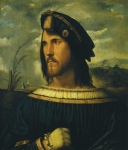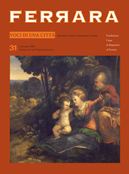A highly noble group of hunters honouring Lucrezia Borgia
Hunting was the favourite pastime of the Este court of Ferrara between the end of the fifteenth century and the beginning of the sixteenth. In fact Leonello of Este was so enamored of it that his tutor, Guarino da Verona, felt obliged to remind him that he should concentrate on his moral development, and other intellectuals were also loud in their criticism of its violence and expense. Nevertheless, the court lived for the hunt. Under Borso of Este's rule, there was a steady increase in the number of delizie (countryside retreats) built, and a ring of reserves was established around Ferrara and along the Po river. Grand hunts were organised here, and the huntsmen and their entourages lodged in villas filled with frescos. It was Borso who neglected the ancient city palace in favour of the newly renovated Palazzo di Schifanoia where the Salone dei Mesi [Hall of the Months] is a celebration of hunting culture. Borso is always depicted in huntingrelated activities in the lower register of the classic architectural cornices, while warrelated scenes were prohibited. Tito Vespasiano (1424-1505) and Ercole Strozzi (1471- 1508), father and son, were hunting companions of the Dukes of Este, and were among the more highly regarded members of the circle. They were men of action as they were politicians, but also intellectuals as they were both poets. Both were distinguished Latin poets, taking Virgil and Ovid as their models. Apart from their mutual interest in politics and poetry, they were also both keen hunters as can be seen by their work. They composed essays on dogs and falcons in addition to long descriptions commemorating or inventing hunts linked to important political occasions. Tito Vespasiano wrote of the young Borso hunting birds in the marshes around Ferrara (VI 115-173) in Borsias. He also wrote poetry on the hunt organised by Filippo Maria Visconti for Borso in the Cusago reserve, which seems to have acted as a model for one of Ercole's hunting poems. The hunt is related to a state visit, and the opportunity for the old Duke of Milan to show the son of his ally the richest, most awe-inspiring image of his power, using the magnificence of the hunt as the medium. Significant political events and the commemoration of historical figures through their hunting achievements can also be found in the greatest work of the young Strozzi, Venatio: the narrative poem of the hunt that Charles VIII of France was going to organise in 1494, on the eve of his disastrous Italian campaign, to ratify his agreement with Ludovico Sforza, "the Moor" of Milan, whose ambassadors Niccolò da Correggio, son of a sister of Ercole I of Este, and Galeazzo Sanseverino, son-in-law of Ludovico, were at the court of Lyons. Relations between the Este, Milan and French duchies were good at that time. Two versions of the poem still remain: a hand-written manuscript and the Aldine edition of 1513 which collects some of the works of Tito Vespasiano and the complete works of Ercole. It tells the story of a hunt and is inspired by both classic and vernacular models: such as the hunt of Aeneas and Dido in Aeneid IV, as it starts at dawn and is interrupted by a storm at midday. It also considers a list of famous hunters just as with the Calydonian Boar in Metamorphoses VIII. However historical characters also feature along with the mythological characters, as in the vernacular hunt writings invented by Boccaccio, Antonio Bonciani and Lorenzo de'Medici. Our poem features the best horses and equipment, and also skill and bravery in the fight against boars, aurochs, and bears, illustrating a group of hunters that do not fear confusion or anachronisms. Charles VIII, Galeazzo Sanseverino, Niccolò da Correggio and the solitary and superb Alcimus are the leading players in the written version, whereas the Aldine edition also features leading figures taking part in the hunt: Ippolito of Este,
hunting poems. The hunt is related to a state visit, and the opportunity for the old Duke of Milan to show the son of his ally the richest, most awe-inspiring image of his power, using the magnificence of the hunt as the medium. Significant political events and the commemoration of historical figures through their hunting achievements can also be found in the greatest work of the young Strozzi, Venatio: the narrative poem of the hunt that Charles VIII of France was going to organise in 1494, on the eve of his disastrous Italian campaign, to ratify his agreement with Ludovico Sforza, "the Moor" of Milan, whose ambassadors Niccolò da Correggio, son of a sister of Ercole I of Este, and Galeazzo Sanseverino, son-in-law of Ludovico, were at the court of Lyons. Relations between the Este, Milan and French duchies were good at that time. Two versions of the poem still remain: a hand-written manuscript and the Aldine edition of 1513 which collects some of the works of Tito Vespasiano and the complete works of Ercole. It tells the story of a hunt and is inspired by both classic and vernacular models: such as the hunt of Aeneas and Dido in Aeneid IV, as it starts at dawn and is interrupted by a storm at midday. It also considers a list of famous hunters just as with the Calydonian Boar in Metamorphoses VIII. However historical characters also feature along with the mythological characters, as in the vernacular hunt writings invented by Boccaccio, Antonio Bonciani and Lorenzo de'Medici. Our poem features the best horses and equipment, and also skill and bravery in the fight against boars, aurochs, and bears, illustrating a group of hunters that do not fear confusion or anachronisms. Charles VIII, Galeazzo Sanseverino, Niccolò da Correggio and the solitary and superb Alcimus are the leading players in the written version, whereas the Aldine edition also features leading figures taking part in the hunt: Ippolito of Este, Cesare Borgia, Michele Marullo, Pietro Bembo, Antonio Tebaldeo, Giovanni Gioviano Pontano, Tito Vespasiano Strozzi, Timoteo Bendedei, Giovanni and Giovan Francesco Pico della Mirandola and Ludovico Ariosto. The increased number of these figures can be explained by the need to change the poem as it had lost its contemporary relevance following the fall of Ludovico in 1500, and his subsequent exile. In the rewritten introduction, the poet does not state that he no longer wishes to sing the praises of the House of Sforza, but along with his final appeal to Apollo, he adds an appeal to a tenth muse, Lucrezia Borgia. She had married Alfonso of Este in 1502. The hunters are characters that form part of the Ferrara court, some of whom are very close to Lucrezia, such as her brother Cesare and Pietro Bembo, or her admirers and bards, such as Tebaldeo, the elder Strozzi and Ariosto. All are friends of the poet. The eulogy therefore changed target: no longer the King of France, and indirectly the Duke of Milan, but Lucrezia Borgia, who had gathered some of the Muses' disciples around her, in addition to the Cesare, Duke of Valentinois who was still very powerful.
Cesare Borgia, Michele Marullo, Pietro Bembo, Antonio Tebaldeo, Giovanni Gioviano Pontano, Tito Vespasiano Strozzi, Timoteo Bendedei, Giovanni and Giovan Francesco Pico della Mirandola and Ludovico Ariosto. The increased number of these figures can be explained by the need to change the poem as it had lost its contemporary relevance following the fall of Ludovico in 1500, and his subsequent exile. In the rewritten introduction, the poet does not state that he no longer wishes to sing the praises of the House of Sforza, but along with his final appeal to Apollo, he adds an appeal to a tenth muse, Lucrezia Borgia. She had married Alfonso of Este in 1502. The hunters are characters that form part of the Ferrara court, some of whom are very close to Lucrezia, such as her brother Cesare and Pietro Bembo, or her admirers and bards, such as Tebaldeo, the elder Strozzi and Ariosto. All are friends of the poet. The eulogy therefore changed target: no longer the King of France, and indirectly the Duke of Milan, but Lucrezia Borgia, who had gathered some of the Muses' disciples around her, in addition to the Cesare, Duke of Valentinois who was still very powerful.



